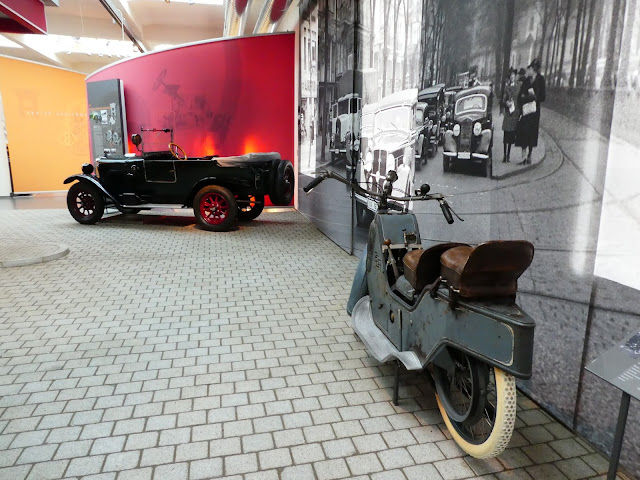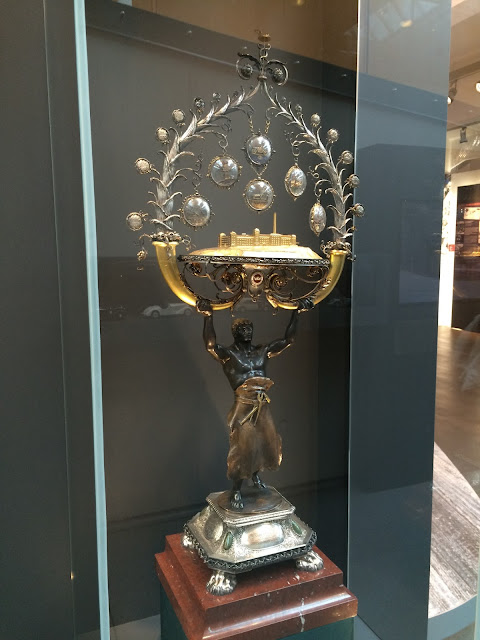
August Horch was the founder of both Horch and Audi and a German automotive pioneer. The August Horch museum follows Horch's career from the time he moved his car factory to Zwickau in Saxonny in 1904, through the Audi years and the foundation of Auto-Union. After the war the Audi plant became the home of the Trabant and the museum normally has a section for the Trabant and East German vehicles, but that section was under renovation when we visited it. The August Horch museum is an excellent museum and interesting even to non-specialists, although almost all the information provided is in Germany. http://www.horch-museum.de/content/50/museum/1/182/

The August Horch museum is in the old Audi factory in Zwickau. The old building to the left of the modern main entrance was Horch's house and office.

The display opens with a replica of the first Horch, the 1904 Horch 14-17.

1916 Horch military truck

1908 Horch 12/28 PS. August Horch gained fame for his company with victories in early motorsport, such as the Prince Heinrich race and the Alpinefahrt. However, it would be Horch's focus on engineering perfection and motor sport to the exclusion of all else that would cause conflict with the Horch company's board of directors. In 1909 he was forced to resign from his own company and went on to found Audi as a competitor and rival.

1914 Audi Type C and 1908 Horch 12/28

Contemporary German street scene diorama


Petrol station display circa 1930 with a 1929 Horch 375 and a 1929 Audi Type SS 'Zwickau.' Audi and Horch competed for the same luxury car market to the detriment of both of them.

Horch rolling chassis

1929 Horch 350 Pullman

1930 Horch 400 police wagen

The Foundation of the Auto-Union in 1932. Behind the scenes there was much furor and political intrigue. Jorge Rasmussen (left), the founder of DKW, had built up a sprawling industrial empire that included dozens of companies ranging from iron foundries, the DKW motorcycle and car company, and even a small aircraft manufacturer. In 1929 he had been encouraged by the Bank of Saxony to buy out the ailing Audi company. Despite a valiant attempt to salvage the company, it was apparent by 1931 that Audi could not be saved and the brand was withdrawn and its factory was turned over to manufacturing Rasmusseun's new DKW 'Frontreib' car. The Bank of Saxony then asked Rasmussen to bail out the equally bankrupt Horch company. Rasmussen did not have sufficient capital to fund this merger, so the Bank of Saxony slipped the well-capitalized and solvent car manufacturer, Wanderer Werkes, into the conglomerate. Rasmussen had expected to be made managing director of the new Auto-Union but as Wanderer had basically funded the merger, the managing directorship went to Wanderer's Baron Klaus von Ouertzen (right). Conflict with the new board led to Rasmussen being sacked and forced out of the company in 1934, while distaste for the Nazis led von Ouertzen to leave Germany for South Africa the following year. The Bank of Saxony appointed Dr Richard Bruhn (centre) as managing director. Dr Bruhn would be instrumental in its post war revival.

Der Vier Ringe


Auto-Union Berlin Auto Show display

1937 Wanderer W24

Wanderer W24

Audi 910

1939 Horch 930S cabriolet.

1939 Horch 930S

Horch model

DKW F7

Auto-Union Type C Silver Arrow
The Auto-Union Type C on display is a replica.

The DKW F7 was Auto-Union's best selling vehicle. Mechanically simple and cost effective yet built to a high standard, they sold in the hundreds of thousand throughout Germany, Europe and around the world.

Horch limousine and a DKW F5 roadster

Audi Front 225

Carosserie display. In the foreground is a DKW F series body and to the rear a traditional wood framed body of a Wanderer coupe. DKW's carosseriewerkes at Spandau was a pioneer of the standardized, production-line car body - but in wood. These standardized self supporting bodies could be pumped out at a rate of hundreds a day and then shipped to DKW's assembly plant in Zwickau. The wood panels were spray painted and then coloured leatherette was stretched over them and glued and nailed into place. The leatherette provided the wood with some weather protection but over time these car bodies tended to rot.

DKW F1 racer. The F1 enjoyed race success in the sub 1 litre class thanks it its tiny, high torque engine and the car's light weight.

The Auto-Union range in 1939. Things were looking up for German industry and then....

Wanderer staff car set among factory ruins opens the way to the military section

1935 DKW 1001. DKW attempted to secure a military contract with a militarized version of the 'big' DKW 1001. It was a doomed attempt however as the 1001 was saddled with DKW's terribly unreliable 4=8 engine. http://heinkelscooter.blogspot.com.au/2016/01/the-big-dkw-48.html

Wanderer W25 staff car.

During the war years the German military standardized vehicle production to reduce complexity and improve supply. The RSO-01 (Rauchschlepper Ost) tracked utility vehicle for Eastern service was originally designed and built by the Austrian Steyr company. The vehicle prove its worth in the appalling conditions on the Russian front and production was distributed to other companies. Auto-Union's Wanderer's factory built 5600.
Here is a link to a restoration project for a Wanderer built RSO-01 https://www.facebook.com/groups/321790801362585

1939 Horch Type 108 1B all terrain vehicle.

1941 Horch Type 40 (KFZ 15). During the war years Horch went from a luxury car manufacturer to a medium to heavy truck manufacturer.

DKW was not excluded entirely from military contracts. The army used a wide variety of DKW's stantionary engines as pumps and generators.

The Wehrmacht were prejudiced against two-stroke engines so DKW received almost no military contracts. Later in the war however, Germany's desperate need for war materiel led the army to abandon its prejudice. DKW's 350 motorcycle was converted to military spec by replacing the chrome exhausts and fittings with cast iron.

Wartime DKW motorcycle advertising. Although Auto-Union's car lines were shut down after 1940 and the factories turned over to war production, DKW's motorcycle and car lines continued. DKW motorcycles were still being built at the end of the war although car production stopped in 1943.

Graphic representation of damage to Auto-Union's (and other companies) factories. Overall Auto-Union survived the war in better condition than other companies. Daimler-Benz's factories for instance were almost totally destroyed. DKW's Zschopau motorcycle and engine plant survived the war undamaged.

The ground floor was dedicated to the Horch and Audi marques. The basement level was dedicated to DKW and Wanderer. Here we see a DKW 300SB, DKW F5 roadster and Wanderer W25K.

DKW F7 in winter spec, with tyre chains, radiator cover and ski-rack. All these options were available from your DKW dealer. http://heinkelscooter.blogspot.com.au/2015/12/dkw-winter-accessories.html

DKW F8. DKW's last pre-war car was externally identical to the earlier F7 but had a new chassis, better brakes and handling.

DKW F5 and Wanderer W25K roadsters

Wanderer's stunning W25K could have been up there with the Mercedes-Benz 300SK.

DKW F5 roadster

DKW Hilfsmotor (help motor). In 1919 DKW developed a small two-stoke motor that could be fitted to a standard bicycle. They were just the thing for transport hungry Germans and set the company on the road to success. DKW quickly progressed from this to building their own motorcycles.

DKW's automobile line had its origin in the DKW Z motorcycle. The Z's 490cc twin cylinder engine had overheating problems so DKW installed a water jacket and radiator. Although the engine didn't really suit a motorcycle, it was good enough to warrant trialing in a budget car. This experiment led directly to DKW's first car, the P-15. http://heinkelscooter.blogspot.com.au/2011/01/dkw-germanys-wonder-car.html

DKW's game changing Frontrieb of 1931. Designed in six weeks at the end of 1930 in order to meet the Berlin Auto Show. It introduced the world to front wheel drive and DKW's new 600cc Schneurle process two-stroke engine. The template established with this car is with us today in Audi's and Volkswagen.

DKW's first car - the 1928 DKW P-15. The car had no chassis but was built around a self supporting plywood body. A two cylinder two-stroke engine was mounted in the front driving the rear wheels. It was an adequate arrangement but three years later DKW would have a new, more powerful engine using the Schnerle process that would create an entirely new car for it - the Front.

The DKW F1 had been designed under Jorge Rasmussen's supervision. The car's successor, the F2, was improved and styled by the new Auto-Union central design office. Part of the design office's role was to economize by standardizing fittings across the marques. The Front range's rapid development went a long way towards establishing a distinctive 'Auto-Union' style.

1930 DKW PS600. The PS600 was DKW's second car. Like its predecessor the P-14, it was powered by a 600cc two cylinder two-stroke engine driving the rear wheels by a traditional transmission. The car was originally developed as a racer and in its first race use by Rasmussen's son Ove it did not have a reverse gear. Nevertheless, the car was handsome and performed well so the car went on sale in 1930. The car was withdrawn in 1931 after the Front was released.

1934 Framo Stromer. After being sacked from Auto-Union, Jorge Rasmussen began working on a new budget car project with Framo, which he had retained ownership of. At Framo Rasmussen attempted to undercut DKW in the budget car market but Framo was too small a concern to be able to compete with his old company. http://heinkelscooter.blogspot.com.au/2013/12/framo.html

The Stromer simplified the concept of the DKW Front to an extreme. The chassis was a simple tube that doubled as the exhaust and the body was leatherette covered plywood. The car was powered by a DKW air-cooled motorcycle engine of 200 or 400ccs. It was advertised as the cheapest car on the German market in 1934 but did not sell particularly well. The car was very small and cramped and not particularly practical. Rasmussen went on to design a four wheeled budget car but it too failed to find a market so Rasmussen retired from the automobile business.

Framo Stromer

Jorge Rasmussen's final attempt to save Audi was the Audi P of 1930. The car was basically a DKW 1001 with a Peugeot 4 cylinder engine. Unfortunately it was too expensive to be a budget car and too basic to appeal to people with money. Less than 100 were built and there are only four or five survivors.

DKW F7 lieferwagen. DKW produced a range of different body styles for their cars. The lieferwagen version was a practical vehicle and sold well. Few however have survived in this format due to their plywood bodies eventually rotting away. http://heinkelscooter.blogspot.com.au/2015/11/dkw-f7-lieferwagen.html

DKW F7 lieferwagen

Horch Pullman

A wanderer with its distinctively scalloped radiator grill.

1939 DKW 1001 Sonderklasse. The all steel Sonderklasse was a new step for DKW. The body shell was basically a re-badged Wanderer but powered by DKW's troublesome 4=8 engine. http://heinkelscooter.blogspot.com.au/2016/01/the-big-dkw-48.html

Wanderer trophy

Before Wanderer moved into cars and motorcycles they manufactured typewriters

1914 Wanderer 2PS motorcycle.

Wanderer started building bicycles in the 1870s before moving into motorcycles after the turn of the century. Wanderer competed in the same market as DKW prior to the merger with Auto-Union, although it was rapidly moving up a class. As part of the merger deal Wanderer's motorcycle arm was sold off to a Czech subsidiary and became the famous Jawa motorcycle company.

Wanderer motorcycle

Mock up of a DKW garage

DKW and Audi Front

Wanderer W24 and Horch 853